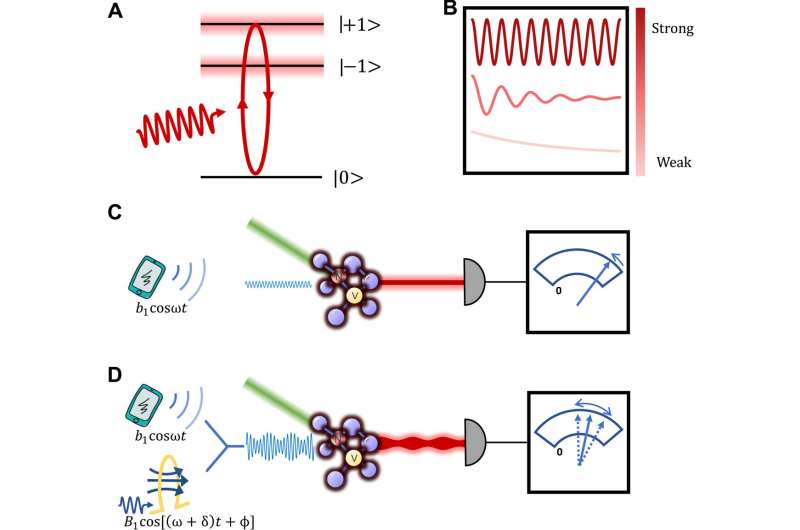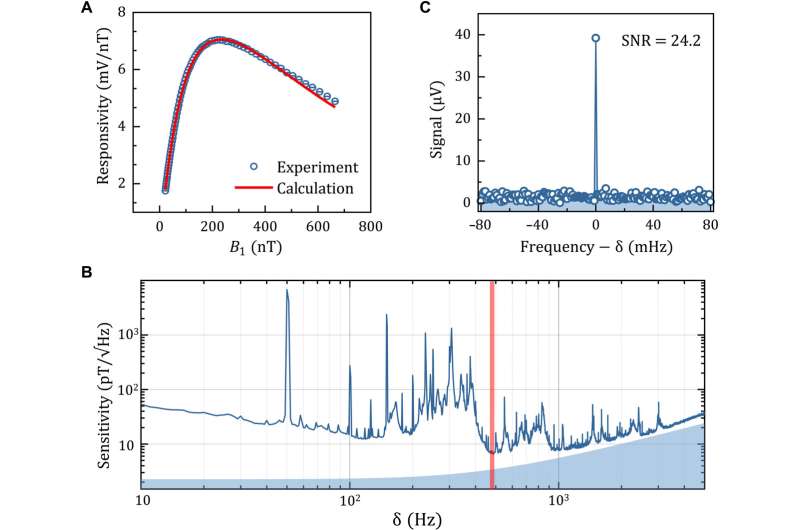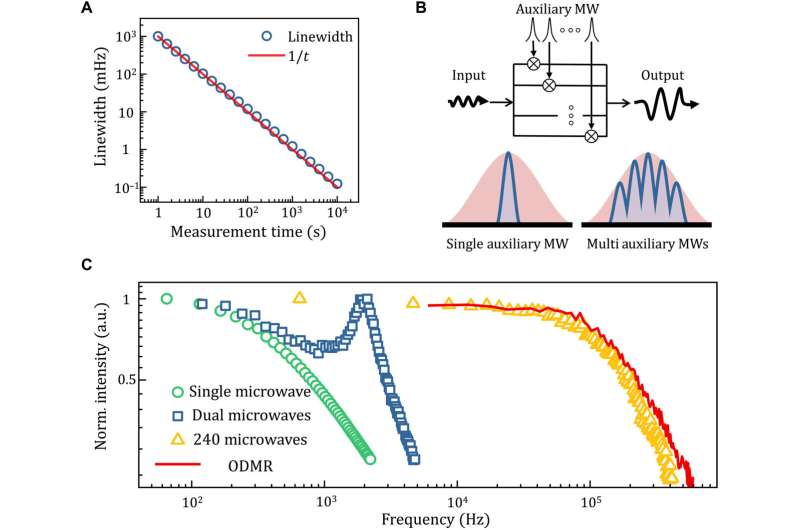Basic principle of continuous heterodyne detection. (A) Simplified energy levels of NV centers. The ∣±1〉 states can be polarized to ∣0〉 state with a rate of Γp. A resonant microwave addresses the ∣0〉 ↔ ∣1〉 spin transition. (B) Evolution of the NV center driven by microwaves of different magnitudes. For a strong microwave, the spin state shows a Rabi oscillation between ∣0〉 and ∣1〉 with frequency Ω proportional to the microwave magnitude. For a weak microwave, the oscillation degrades to an exponential decay with a rate proportional to the square of microwave magnitude. (C and D) Comparison of direct and heterodyne detection. The competition between laser-induced polarization and microwave-induced relaxation leads to an equilibrium spin state. For direct detection (C), constant microwave magnitude results in DC fluorescence signal. For heterodyne detection (D), the microwave interference results in a time-varying magnitude and thus an AC fluorescence signal. Credit: Science Advances (2022). DOI: 10.1126/sciadv.abq8158
Microwave field sensors are important in practice for a variety of applications across astronomy and communication engineering. The nitrogen vacancy center in diamond allows magnetometric sensitivity, stability and compatibility with ambient conditions. Despite that, the existing nitrogen vacancy center-based magnetometers have limited sensitivity in the microwave band.
In a new report now published in Science Advances, Zeching Wang and a team of scientists at the University of Science and Technology of China, presented a continuous, heterodyne detection scheme to improve the sensor's response to weak microwaves in the absence of spin controls. The team achieved a sensitivity of 8.9 pTHz-1/2 for microwaves via an ensemble of nitrogen vacancy centers within a specified sensor volume. The work can benefit practical applications of diamond-based microwave sensors.
Advanced applications of microwave sensing
The sensitivity of most modern applications that range from wireless communication to electron paramagnetic resonance and astronomical observations can be improved via advances in microfield detection methods. Researchers have already developed a variety of quantum sensors in the past decade with enhanced capabilities. Among them, the nitrogen vacancy center is identified by its unique properties for on-chip detection, although it suffers from relatively low sensitivity. Scientists can use nitrogen vacancy ensembles to substantially improve the sensitivity of the diamond magnetometer.
In this work, Wang and others proposed a continuous heterodyne detection scheme to improve the sensor's response to weak microwave fields by introducing a moderate and slightly detuned auxiliary microwave. The outcome made the scheme applicable to larger diamond sensors with improved sensitivity with great practical benefits.
Conducting the experiments and optimizing the sensitivity
The nitrogen vacancy electron spin maintained a triplet ground state consisting a bright state and two degenerate dark states that can be lifted by an external magnetic field. The team removed the complicated control pulses to perform the experiments on a simple setup. During the work, they used an optical compound parabolic concentrator to increase the fluorescence collection efficiency. As proof of concept, the researchers radiated signal and auxiliary microwaves from a 5-mm-diameter loop antenna, and applied an external magnetic field perpendicular to the diamond surface of all NV centers to have the same Zeeman splittings.
Optimal sensitivity. (A) Dependence of responsivity on auxiliary microwave field. Points are experimental results, where error bars indicate the RMS of baseline in Fourier transform spectra around δ = 480 Hz with a span of 0.1 Hz. The solid line is the theoretical calculation according to Eq. 16 in Materials and Methods. (B) Dependence of sensitivity on heterodyne frequency δ. The sensitivity is normalized according to the detection bandwidth. The red area indicates the optimal frequency window around 480 Hz. The blue area indicates the estimated shot noise–limited sensitivity. (C) Benchmark of sensitivity. The Fourier transform spectrum corresponds to a signal microwave field of 6.81 pT. The total measurement time is 1000 s. The measured SNR of 24.2 corresponds to a sensitivity of 8.9 pT Hz−1/2. Here, the auxiliary microwave field is 220 nT with δ = 480 Hz. Credit: Science Advances (2022). DOI: 10.1126/sciadv.abq8158
During the experiment, the team first applied a single-channel resonant microwave. They then applied an auxiliary microwave and extracted the frequency to obtain the difference of the two microwaves, alongside the signal of the heterodyne measurement. The research team optimized the sensor's performance by improving the signal-to-noise ratio. Since the laser maintained a strong noise in a low frequency band, the team increased the heterodyne frequency to avoid this effect. The researchers then intuitively benchmarked the sensitivity of the sensor and also took the frequency resolution into account as well as the detection bandwidth.
Outlook
In this way, Zeching Wang and colleagues showed the possibility of using nitrogen vacancy centers as highly sensitive sensors for microwave magnetometry even in the absence of spin controls. The method depended on the resonant absorption of microwaves, facilitated by nitrogen vacancy centers. They applied the scheme to a diamond hosting nitrogen vacancy ensemble to achieve a minimum detectable microwave field. The simplicity of the scheme allows the measurements to be directly reproduced on larger sensors for further improved sensitivity. For instance, with diamonds having a similar size to the photodiode, the sensitivity can be promoted to the femtotesla level. Increased nitrogen vacancy density improved the overall sensitivity, although an increase in relaxation state and laser-heating issues had to be balanced.
Linewidth and bandwidth. (A) Dependence of linewidth on the total measurement time. The blue points are experimental results extracted from the Lorentz fits of Fourier transform spectra. The red line indicates the 1/t scaling. (B) Intuitive concept of bandwidth extension. The diamond “mixer” has a narrow-band response to the input microwave, where the band is centered at the frequency of the auxiliary microwave. If we cascade multiple mixers with different auxiliary microwaves, the band will be extended accordingly. (C) Measurements of bandwidth. All groups of measurements are normalized for better comparison of the bandwidth. The extended bandwidth consists of the ODMR linewidth. a.u., arbitrary units. Credit: Science Advances (2022). DOI: 10.1126/sciadv.abq8158
The work has a long-standing impact for practical applications of diamond sensors as microwave receivers in radars during wireless communication and in radio telescopes. The diamond device can also function under extremely high temperature or pressure with additional capacity to facilitate the development of an on-chip diamond magnetometer.
More information: Zhecheng Wang et al, Picotesla magnetometry of microwave fields with diamond sensors, Science Advances (2022). DOI: 10.1126/sciadv.abq8158
Donggyu Kim et al, A CMOS-integrated quantum sensor based on nitrogen–vacancy centres, Nature Electronics (2019). DOI: 10.1038/s41928-019-0275-5
Journal information: Nature Electronics , Science Advances
© 2022 Science X Network


























